-
-
Access Free Student Software
Ansys empowers the next generation of engineers
Students get free access to world-class simulation software.
-
Connect with Ansys Now!
Design your future
Connect with Ansys to explore how simulation can power your next breakthrough.
Countries & Regions
Free Trials
Products & Services
Learn
About
Back
Products & Services
Back
Learn
Ansys empowers the next generation of engineers
Students get free access to world-class simulation software.
Back
About
Design your future
Connect with Ansys to explore how simulation can power your next breakthrough.
Free Trials
ANSYS BLOG
April 5, 2024
Academic Spotlight: Exploring Healthcare Solutions Through Simulation
From the stress of carrying a heavy backpack to analyzing artery plaque, students around the world are discovering innovative healthcare solutions one simulation at a time.
With access to Ansys simulation through the Ansys Academic Program, students are leveraging multiphysics modeling to advance their studies and, potentially, the healthcare industry. The program provides universities with deeply discounted software for use in the classroom or in research while offering students access to free downloadable software and additional online resources for self-learning. In connection, students can access more than 400 free Ansys Innovation Courses, as well as other open-learning material available to academia through Ansys Innovation Space. Currently, the program reaches more than 2,900 universities across 82 countries with software and resources spanning a wide range of engineering disciplines, including structures, fluids, and electromagnetics.
Let’s explore some of the exciting ways students and educators are integrating Ansys simulation to unlock new possibilities within the healthcare industry.
Applying FEA for Musculoskeletal Health
High schooler Anish Sarkar used Ansys Mechanical finite element analysis (FEA) simulation for his project “Impact of Heavy Loads on the Human Backbone.” His research not only concluded the safest way to wear a backpack for optimal musculoskeletal health, but also landed him second place at the 2022 Golden Gate STEM Fair in California. The regional fair welcomes local science, technology, engineering, and mathematics (STEM) students in grades six through 12.
Sarkar used three models for his simulations: a basic spine and ribcage model that he created using Ansys SpaceClaim and two models he found online of a skeleton and a muscle-focused model of the human body. After refitting the online models using SpaceClaim, he generated mesh for each model in Mechanical. Next, he added pressure points to indicate where the pressure and weight of the backpack was present in each scenario. He also used Ansys Granta MI Enterprise to set up organic material properties for the simulations.
Sarkar determined that the healthiest way to wear a backpack is to position the straps on both shoulders without pulling or tightening the shoulder straps downward. This ensures that the pressure and weight of the backpack sits loosely at the lower back instead of the upper or middle back.
The following year, Sarkar turned his focus toward amputees, aiming to improve prosthetic design for veterans. He used SpaceClaim and Mechanical to prepare prosthetic socket models and conduct a comprehensive analysis of stress, strain, and load distribution in the interface between the residual limb and the prosthetic socket throughout the gait cycle.
Sarkar’s software-based design approach and analysis demonstrated the ability to customize sockets for every patient much more efficiently than traditional socket lamination techniques, which are time consuming and require more physical resources. He submitted this project to the Golden Gate Science Fair as well and received the Lemelson Young Inventor and Chevron Special awards.
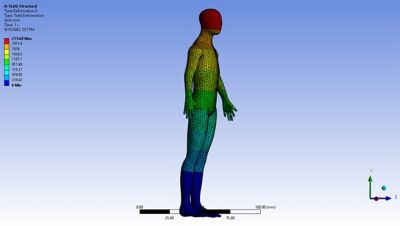
High school student Anish Sarkar used Ansys Mechanical to analyze stress and pressure points along the spine for his project “Impact of Heavy Loads on the Human Backbone.”
Integrating CFD for Vascular and Respiratory Health
Female high schoolers participating in the EnQuest program explored real-life patient case studies involving artery blood flow and aneurysms using Ansys Fluent computational fluid dynamics (CFD) software. Hosted by the University of Wisconsin-Milwaukee (UWM), EnQuest is one of many female-focused programs hoping to bridge gender gaps in the engineering industry.
Students in a 2022 summer program participated in real-world research thanks to their session leader Mahsa Dabagh, an assistant professor of biomedical engineering at UWM whose research focuses on cancer and vascular diseases.
The group helped her analyze patient case studies concerning artery blood flow and aneurysm detection. Based on patient-specific images, the team built 3D geometries of large cerebral vascular arteries, most of which contained aneurysms. With Fluent, the team examined correlations between blood distribution inside aneurysms and regions of aneurysms that are more prone to rupture.
“Ansys is more user friendly and accurate than other software, and it provides more options like post-processing visualization,” says Dabagh. “I wanted students to learn as much as possible and not struggle with learning how to choose boundary conditions or how to post-process, and Ansys is easier to follow for students with user-friendly interfaces and trustable results. It has high reliability and is easy to import different files. These are all features that Ansys has that are quite unique.”
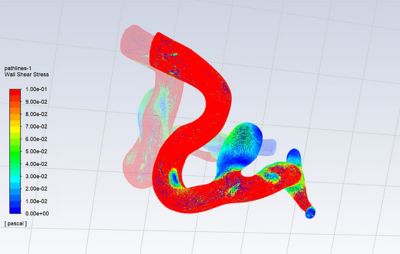
EnQuest students used Ansys Fluent to simulate the wall shear stress of an aneurysm within an artery.
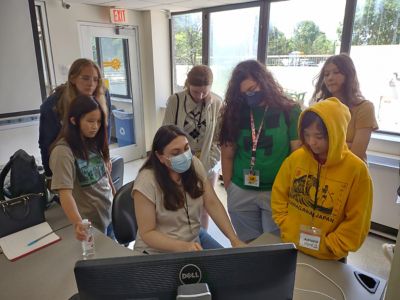
Students in the EnQuest program helped Mahsa Dabagh, an assistant professor of biomedical engineering at the University of Wisconsin-Milwaukee, with real-world vascular research.
In another example of applying CFD to vascular research, Chris Zhou used SpaceClaim and Fluent in high school to model and analyze blood flow in the carotid artery. His senior-year AP capstone project, titled “CFD Analysis on the Carotid Artery Bifurcation,” received a perfect score — a milestone achieved by just 1% of students globally at the time.
Zhou prepared his models in SpaceClaim, creating geometry, mesh, and boundary conditions. He used Fluent to analyze blood flow characteristics, including the correlations between healthy flowing arteries and arteries in which a blockage is forming.
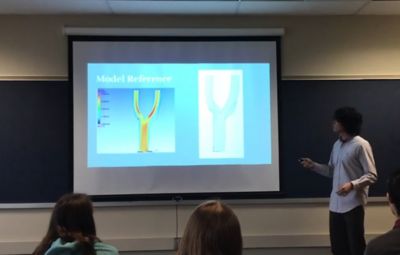
Chris Zhou presents his senior-year AP capstone project “CFD Analysis on the Carotid Artery Bifurcation.”
Several students at Oklahoma State University (OSU) also use Fluent to examine artery blood flow, thanks to chemical engineering associate professor Yu Feng. Feng integrates Fluent into select undergraduate and graduate courses to complete research projects, including the examination of transient blood flow in arm arteries, topical ocular drug delivery through 3D eyeball models, and airborne transmission of virus-laden droplets in between digital twin human respiratory systems.
In addition, Feng incorporates other Ansys tools into coursework, including:
- Mechanical for solid mechanics simulation and fluid–structure interaction.
- Ansys CFX for CFD simulations as an alternative to Fluent.
- Ansys EnSight for post-processing simulation data and visualization.
- Ansys Discovery for quick engineering simulation and analysis.
- Ansys Workbench for fluid–structure interaction and batch process for simulations, as well as training and testing for reduced-order models (ROMs).
- Ansys Rocky for particle–particle interaction simulations.
“Chemical engineering students who master Ansys Fluent and CFX have achieved remarkable success in their careers after completing their undergraduate education,” says Feng. “They have skillfully applied the knowledge they gained from my multiphase flow course, and their success can be attributed to their proficiency in Ansys software, including Fluent, CFX, Mechanical, Rocky, and others.”
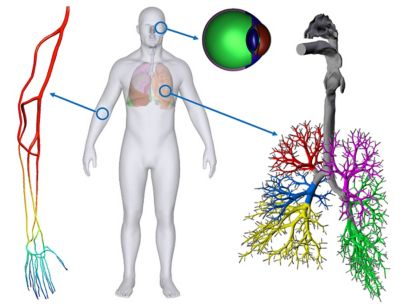
Research examples of lung aerosol dynamics, hemodynamics in arm arteries, and topical ocular delivery optimization demonstrated using Ansys simulation and a virtual human model developed by the Computational Biofluidics and Biomechanical Laboratory (CBBL) at Oklahoma State University (OSU).
Learning Beyond the Classroom
Outside of the classroom, Feng implements Ansys software to promote the next generation of STEM through multiple outreach activities for K-12 students, undergraduate students, and the local community in Oklahoma. Main activities include the Lungevity initiative hosted by the OSU Alumni Association and the Summer Bridge program, which is organized by the OSU’s College of Engineering, Architecture, and Technology (CEAT).
Along with outreach, Feng’s students have access to an on-site research lab with state-of-the-art models and equipment. Through the academic partnership between Ansys, Engineering Simulation and Scientific Software (ESSS), and the Computational Biofluidics and Biomechanics Laboratory (CBBL) at OSU, Feng and peers developed a CFD–discrete element method (DEM)-based human respiratory system modeling framework that includes a clinically validated elastic whole-lung model.
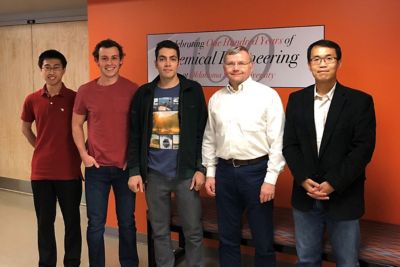
Thierry Marchal, an industry director for healthcare solutions at Ansys (second from right), visits Yu Feng, a chemical engineering associate professor at OSU (far right), and past lab members at the CBBL in 2017.
Supporting learning beyond the classroom, Ansys attends many healthcare-focused academic events and conferences. Some of these events include:
- International Brain Stimulation Conference
- Cardiac Digital Twin Workshop at King’s College of London
- International Symposium on Computer Methods in Biomechanics and Biomedical Engineering
- Masters of Aorta and Structural Heart Surgery
- IA4Care Forum hosted by Santenov
- Functional Imaging and Modeling of the Heart
- Digital Engineering Advancing Healthcare: RF Electromagnetics for Medical Implants hosted by CADFEM, an Ansys channel partner
Ansys is committed to the advancement of STEM education while ensuring the accessibility and affordability of simulation tools. For more information, visit Ansys Academic.